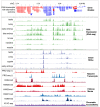Genomics of the Parasitic Nematode Ascaris and Its Relatives
- PMID: 33800545
- PMCID: PMC8065839
- DOI: 10.3390/genes12040493
Genomics of the Parasitic Nematode Ascaris and Its Relatives
Abstract
Nematodes of the genus Ascaris are important parasites of humans and swine, and the phylogenetically related genera (Parascaris, Toxocara, and Baylisascaris) infect mammals of veterinary interest. Over the last decade, considerable genomic resources have been established for Ascaris, including complete germline and somatic genomes, comprehensive mRNA and small RNA transcriptomes, as well as genome-wide histone and chromatin data. These datasets provide a major resource for studies on the basic biology of these parasites and the host-parasite relationship. Ascaris and its relatives undergo programmed DNA elimination, a highly regulated process where chromosomes are fragmented and portions of the genome are lost in embryonic cells destined to adopt a somatic fate, whereas the genome remains intact in germ cells. Unlike many model organisms, Ascaris transcription drives early development beginning prior to pronuclear fusion. Studies on Ascaris demonstrated a complex small RNA network even in the absence of a piRNA pathway. Comparative genomics of these ascarids has provided perspectives on nematode sex chromosome evolution, programmed DNA elimination, and host-parasite coevolution. The genomic resources enable comparison of proteins across diverse species, revealing many new potential drug targets that could be used to control these parasitic nematodes.
Keywords: Ascaris; chromatin; chromosome; comparative genomics; evolution; genome; histone modification; parasitic nematode; small RNA; transcriptome.
Conflict of interest statement
The authors declare no conflict of interest.
Figures


Similar articles
-
Programmed DNA elimination in the parasitic nematode Ascaris.PLoS Pathog. 2023 Feb 2;19(2):e1011087. doi: 10.1371/journal.ppat.1011087. eCollection 2023 Feb. PLoS Pathog. 2023. PMID: 36730159 Free PMC article. Review.
-
Comparative genome analysis of programmed DNA elimination in nematodes.Genome Res. 2017 Dec;27(12):2001-2014. doi: 10.1101/gr.225730.117. Epub 2017 Nov 8. Genome Res. 2017. PMID: 29118011 Free PMC article.
-
Chromosome fusion and programmed DNA elimination shape karyotypes of parasitic nematodes.bioRxiv [Preprint]. 2023 Dec 23:2023.12.21.572835. doi: 10.1101/2023.12.21.572835. bioRxiv. 2023. Update in: Curr Biol. 2024 May 20;34(10):2147-2161.e5. doi: 10.1016/j.cub.2024.04.022. PMID: 38187595 Free PMC article. Updated. Preprint.
-
Ascariasis in people and pigs: new inferences from DNA analysis of worm populations.Infect Genet Evol. 2012 Mar;12(2):227-35. doi: 10.1016/j.meegid.2012.01.012. Epub 2012 Jan 28. Infect Genet Evol. 2012. PMID: 22306815 Review.
-
Ascaris from Humans and Pigs Appear to Be Reproductively Isolated Species.PLoS Negl Trop Dis. 2016 Sep 1;10(9):e0004855. doi: 10.1371/journal.pntd.0004855. eCollection 2016 Sep. PLoS Negl Trop Dis. 2016. PMID: 27583548 Free PMC article. No abstract available.
Cited by
-
End resection and telomere healing of DNA double-strand breaks during nematode programmed DNA elimination.Nucleic Acids Res. 2024 Aug 27;52(15):8913-8929. doi: 10.1093/nar/gkae579. Nucleic Acids Res. 2024. PMID: 38953168 Free PMC article.
-
Small RNA pathways in the nematode Ascaris in the absence of piRNAs.Nat Commun. 2022 Feb 11;13(1):837. doi: 10.1038/s41467-022-28482-7. Nat Commun. 2022. PMID: 35149688 Free PMC article.
-
Programmed DNA elimination in the parasitic nematode Ascaris.PLoS Pathog. 2023 Feb 2;19(2):e1011087. doi: 10.1371/journal.ppat.1011087. eCollection 2023 Feb. PLoS Pathog. 2023. PMID: 36730159 Free PMC article. Review.
-
Redescription and new record of Paracapillaria (Ophidiocapillaria) najae (Nematoda: Trichuroidea) in the monocled cobra Naja kaouthia from central Thailand: morphological and molecular insights.Parasitology. 2023 Sep;150(10):901-910. doi: 10.1017/S0031182023000707. Epub 2023 Jul 31. Parasitology. 2023. PMID: 37519244 Free PMC article.
-
Molecular epidemiology of Ascaris lumbricoides following multiple rounds of community-wide treatment.Nat Commun. 2025 May 9;16(1):4321. doi: 10.1038/s41467-025-59316-x. Nat Commun. 2025. PMID: 40346057 Free PMC article.
References
-
- Hotez P.J. The Unholy Trinity: The soil-transmitted helminth infections ascariasis, trichuriasis, and hookworm infection. Forgot. People Forgot. Dis. ASM Press. 2013:17–40. doi: 10.1128/9781555818753.ch2. - DOI
Publication types
MeSH terms
Grants and funding
LinkOut - more resources
Full Text Sources
Other Literature Sources

